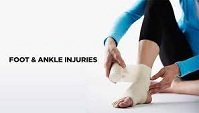
Effective Ways to Care for a Foot and Ankle Injury

To think only those individuals who engage in intense sports are susceptible to foot and ankle injury is a gross misconception.
If truth be told, most people have (and will most likely) experience foot and ankle injury at one point in their lives or another.
While most movements will not result to injuries, some symptoms can be attributed to everyday wear and tear as well as overuse.
In majority of the cases, injuries of the foot and ankle often occur during:
- Sports or recreational activities
- Chores or projects done at home
- Chores that are work-related
Soccer and basketball players, gymnasts, and dancers are highly susceptible to foot and ankle injuries as opposed to those who are not engaged in the fields as physically challenging and competitive.
For older adults, osteopenia (loss of bone strength) and muscle mass will often predispose them to injuries and fractures. Vision and balance problems will also significantly increase their injury risk.
Foot and ankle injuries in children can often be attributed to falls, sports, and play. Those that sustain bone injuries near the joint will have to be assessed accordingly as the physis (grown plate) might be compromised.
Fortunately, minor cases of foot and ankle injuries will often respond well to home treatments.
However, acute injuries that resulted from jamming, bending, fall, twisting, direct blows, etc. will require immediate medical attention.
This is especially true when bruising and swelling will manifest.
Other conditions that will need instant medical attention include:
Sprains
Sprains that are persistent are sometimes attributed to a condition known as osteochondritis dissecans. To play safe, it would be best to check with a doctor right away so the condition is resolved before it complicates.
Puncture wounds
Sharp objects like needles, nails, tacks, and knives often cause puncture wounds. Sans treatment and medical attention, puncture wounds can result to infections.
Strains
Pulled muscles in the ankle or foot can be subjected to strains. In worse case scenarios, it can lead to ruptures.
Contusions
In some instances, contusions or bruising can occur during foot and ankle injuries. To ensure your safety and to ease any pain you might experience, consider seeing the doctor a must.
Thankfully, there is no shortage of treatment options available for foot and ankle injuries—physical therapy, first aid measures (brace, splint, and cast), special shoes (with orthotic devices), medications, etc.
The treatment option administered will depend on certain key factors including the following:
- The severity, location, and type of the injury
- When the injury occurred
- The patient’s overall condition
- The patient’s activities (sports, hobbies, work, etc.)
- The patient’s age
For cases of minor foot and ankle injuries, the following treatment tips can help effectively reduce stiffness and swelling and ease pain:
- To reduce swelling, it is advisable that patients should avoid activities that can cause more swelling—alcoholic beverages, hot packs, hot tubs, and hot showers—at least for the first 48 hours after the injury,
- Massage or gently rub the injured area to reduce pain and encourage blood flow. However, it is not advisable to massage the injured area when the patient feels pain.
- Once the swelling is reduced or disappears, patients are encouraged to perform gentle exercises to help restore flexibility. Alternating between heat and cold treatments is also often recommended.
- Gentle movement, strength, and alternate (MSA) exercises are also recommended to help hasten the healing process.
Movement
After the injury, regaining full motion range is always a top priority. After the injured area has been rested for 24 to 48 hours, moving it gradually is encouraged, stopping only when pain is experienced. To ensure formation of scar tissue is prevented, gentle exercises are also prescribed.
Strength
When there’s no more swelling and the movement range has been restored, the next immediate goal would be to strengthen the area injured.
Alternate activities
While healing, it is advised that certain activities and exercises are incorporated in the daily routine. This is especially advisable a few days after the injury occurred. However, it is advisable that the activities integrated will not put strain on the area injured.

Leave a Reply